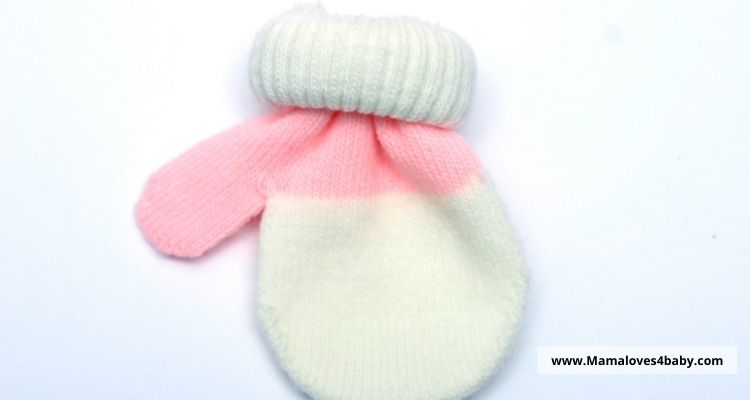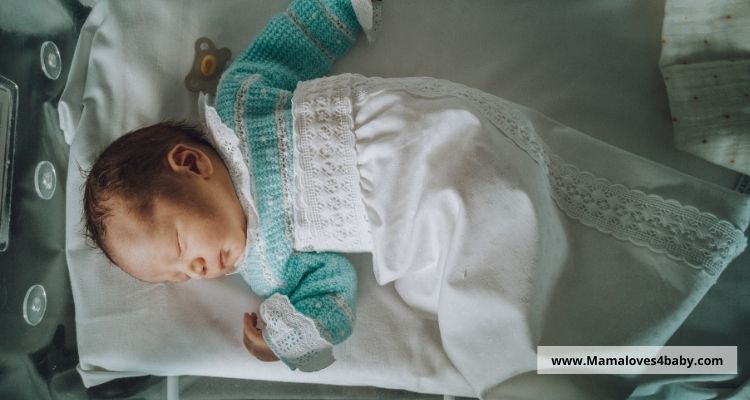Are you among parents of young babies struggling with how to keep Baby’s hands warm at night during winters? Babies are curious, and they often put things in their mouths, which makes them prone to cold, distress, and unwell, so they need to be protected.
I understand during the winter months, keeping your baby warm is challenging. Typically the coldest part of the day is from 7 pm to 7 am. But, it does not mean that you cover your baby with too much clothing or use too many blankets, as it will overheat your child. And your baby will become uncomfortable!

Should I cover my Baby’s hands at night?
Should you cover your baby’s feet at night? If so, the answer is a clear yes. The child’s hands and feet help regulate body temperature and send heat up into the body during sleep. The next questions comes in parents mind is how to keep babies hands warm at night? However, there are certain precautions parents need to take to prevent suffocation and smothering. Below are some tips to keep the baby warm at night.
Parents need to practice safe sleeping habits for their children.
Related: Best Organic Swaddle Blankets For Newborns
6 Things to do: How to keep baby’s hands warm at night
1. Always maintain the baby’s room temperature.
Before layering your child, it is better to consider maintaining a comfortable temperature between 68 -72 °F, as recommended by the American Academy of Pediatrics. It will also improve your baby’s nighttime sleep and make them less vulnerable to getting cold, flu, and cough.
2. Use a bassinet or baby’s crib.
Parents can use bedside bassinets for sleeping newborns at night. In this way, they have their own space without any disturbance. AAP recommends that parents have a firm crib mattress and place their little ones on the back while sleeping. Moreover, avoid using toys, loose blankets, and crib sheets as they can cause suffocation to infants.

3. Use Swaddles
Alternatively, you can use different baby swaddles to wrap your baby appropriately, giving a comfy space like a mother’s womb. Swaddles help keep the baby’s cold hands and feet tucked inside the cloth so the baby stay warm and secure. Thus, infants sleep for longer hours.
4. Use Mittens
There are pros and cons to wearing mittens on keeping the baby warm on cold winter days. Infants are susceptible to changes in temperature. Their hands lose body heat much faster than older children’s. Their hands are also not covered with body fat, contributing to blue fingers. Mittens help keep your child’s hands warm, but they should be removed when the child is no longer in cold weather.

The main benefit of wearing mittens to keep your child’s hands warm at night is that it prevents your infant from scratching their face or injuring their delicate skin. The problem is that mittens are challenging to keep on, and your baby is likely to try to pull them off. So instead, try putting on baby socks. Covering your child’s hands will help prevent scratches and scrapes on their face.
Long sleeve onesie with foldover mittens is another good choice if your baby hands feel cold. Similarly, infants should wear socks up to the knee to keep feet warm at night.
5. Use wool
Should I cover my baby’s hands at night? well using wool to keep babies’ cold hands warm at night is an excellent choice. Wool provides warmth without the need for the extra effort on the part of the parent. It is also soft and breathable, ensuring your baby stays comfortable even when they are damp.

6. Sleep sack
Another option for keeping babies’ hands warm at night is to put them in sleep sacks Sleep sacks are sleeveless and should be worn with a long-sleeved cotton romper. The romper will trap the heat that the sleep sack provides. You can consider woolino sleep sacks or polyester fleece sleep sacks for your little one.
The most effective way to keep your baby warm at night is to protect their core temperature. You can get them to sleep sacks that are sleeveless and must be worn with a long-sleeved cotton romper. These sleep sacks will help trap your baby’s body heat. Also, make sure your baby wears socks up to the knee, which will help keep their feet warm.
Things to Avoid: How to keep baby’s feet warm at night?
Let’s explore further how to keep baby’s hands warm at night without swaddling.

1. Hats
A baby should not wear a hat to sleep, but most newborns can safely sleep without them. However, if the room temperature is below 16 degrees Celsius, it is advised that you keep hats off your newborn while they sleep. They may suffer from overheating or slip off their face at night, which increases their risk of SIDS. To regulate their body temperature, they should wear soft hats or bonnets.
A newborn’s head loses about 20% of its body heat through its head. A lightweight cotton “beanie hat” is a safe choice for a baby to wear at night. It is also free of strings, which can get tangled around your Baby’s neck and interfere with breathing. However, it’s best to avoid hats made of wool or other warm materials for babies.
2. Escape suffocation hazard

Infants are at increased risk of suffocation if their hands and arms are covered at night. Especially when young and premature, they may struggle to control their neck. To help prevent suffocation, make sure the baby is visible and not squeezed into any loose bedding. Room sharing with an adult or other child is also recommended during the first six months of life.
3. Overbundling
Mostly new parents are unaware of how to keep baby’s hands warm at night. they over-bundle their babies. More layers can put your infant at risk for SIDS, the sleep-related death syndrome. Babies need to lose heat to regulate their body temperature, and over-bundling in a warm room can weaken the breathing pattern and prevent the baby from waking up in time to breathe.
4. Space heaters
There are several cautions to take when using a space heater in your Baby’s room. It would help if you only used space heaters that self-regulate and do not generate too much heat. So always remember such heaters must be kept out of reach of the child. Moreover, space heaters should not be used for longer than one or two hours since they can turn the nursery into a mini-summer.
5. Overdressing
While you are learning how to keep baby’s hands warm at night? let me tell you overdressing your baby is a big no-no. It leads to discomfort, but it can also put your baby at risk for Sudden Infant Death Syndrome (SIDS). Babies are particularly vulnerable to overheating, leading to tissue damage and organ failure. It is especially true for babies under six months of age. Parents can help prevent overheating by using indoor thermometers and dress baby appropriately.
6. Avoiding covering Baby’s face or head
Babies lose heat through their heads. Therefore, covering a baby’s head can make them overheat. Also, headwear can become a choking hazard. It is essential to consider that infants under a year old can suffocate if duvets or covers fall on their heads. It is because children’s bodies cannot regulate their temperature until two.
7. Avoid duvets with a TOG rating above four.
One important thing to remember when learning how to keep babies hands warm at night is to avoid using duvets. Duvets can be too warm for a baby under one year and can also be a suffocation risk. A baby’s body temperature can’t regulate itself until around two years old so the extra warmth can cause discomfort.
Baby’s hands are a significant source of warmth during the night. kids will often explore objects in their environment and put them into their mouths. It means that keeping their hands warm is vital. Eventually, they will be able to do more of these tasks independently, and they won’t need to keep their hands warm. But a duvet can still be a good idea if it has a TOG rating below four.
8. Fleece
Fleece doesn’t breathe well and may not soak up moisture as quickly as wool. This moisture can lead to chilling. Also, unlike wool, it is tough to wash and will cause stains.
9. Socks
When adding socks on babies, the first rule of thumb is to make sure they are soft and breathable. Avoid tight-fitting ones, as they can restrict blood flow and lead to sock-line hyperpigmentation. Loose socks, meanwhile, can wiggle out and pose a choking hazard. Lastly, make sure the socks are without embellishments, as these can be choking hazards.
Newborns have poor circulation, so their hands can freeze even when fully dressed. Babies should wear extra layers to prevent their hands from becoming overly cold, leading to SIDS. Baby socks that are elastic around the edges are excellent.
10. Wool clothes
Keeping your baby’s warm in frigid winter nights does not have to be a huge hassle. Wool is very moisture-wicking and can keep your hands warm without trying too hard. It also prevents moisture from being trapped in your baby’s skin, essential during cold months .
The best ways to How to Keep Baby Warm at Night Without swaddle
New parents are probably wondering how to keep baby warm without swaddle. There are a few alternatives to wrapping, such as Wearable blankets or wool. These materials are breathable and soft. Or you can include dressing your baby in removable layers. Hence, I have listed a few suggestions below. Hopefully, they will work for you and your little one.
Duvets
If your baby does not like to be swaddled, then, Duvets can play a role in helping you. Babies cannot regulate their body temperature on their own. However, electric blankets or hot water bottles can cause burns to your baby. You must take the hot water bottle out of your baby’s body before letting him sleep. But duvets and sleep bags have been safe for infants for over a year. Duvets are also safe for wriggling toddlers with a TOG rating below four.
Sleep sacks
The sleep sacks from Swaddle Up is designed with safety in mind. It offers a secure fit without swaddling, great for weaning your child off from tight wrapping. According to the owner of Love to Dream, Hana-Li Krawchuk, the sleep sack should be introduced once your baby rolls over. The material is stretchy and runs more considerable than a swaddle wrap. It is suggested to select a sack that fits according to your child’s height and weight.

Simple-to-remove cloth layers
A swaddle is a traditional method to keep your baby warm at night, but current health practitioners advise against putting your baby to bed in a swaddle. It is dangerous for your baby to be overheated, and it also causes the risk of SIDS. Luckily, several easy-remove layers can provide adequate warmth for your child without a swaddle.
Changing diapers frequently
Changing diapers can also keep your baby toasty warm without swaddling. One great idea to how to keep baby warm at night without swaddling is changing diapers frequently. Babies are intuitive to the cold, and wet diapers feel pretty cold. It is especially true when air can get through them, so changing your baby’s diaper is essential. Changing a damp diaper will keep your baby warm at night and avoid diaper rash.
Covering child’s hands
Another way to keep your baby warm without swaddling during winters is to wrap him in a soft cotton blanket. In this way, your child’s body temperature is regulated through the layers of clothing, and her hands are covered. However, keeping your baby warm at night is essential, and it’s easy to get your hands cold when he tries to wiggle them out. You might even consider a humidifier to prevent skin from drying out from the heat.

Wearable soft material blankets
If your child feels cold and likes to sleep in a swaddle, you can also try a sleeveless wearable blanket. While swaddling can be safe, it may increase the risk of more or startle reflexes. While these can benefit your child during cold winter nights or even spring weather, you should never swaddle your baby for long hours.
Related: How to teach baby to sleep without swaddle?
A baby warmer can be a sleeping bag, a nighttime bodysuit, and long-sleeved pajamas. To keep your baby warm at night:
- You can consider a single blanket made of incredibly soft cotton with breathable holes.
- Look for features like face and rollover alerts, and don’t forget to check the size and safety rating of the blanket.
- If your child is underweight, try a cotton sleep bag.
Wool
Have you heard that wool is safe for babies? Yes, wool is a breathable material that helps regulate your baby’s temperature, keeping them warm and comfortable without the swaddling.
It also absorbs moisture, keeping the baby dry and warm at night without swaddling. Babies can breathe quickly, so wool is an excellent choice for maintaining comfortable temperatures and sleeping babies. You can use wool in a 4-season sleep sack for the most comfortable rest to keep your little one warm.
Conclusion
Preventing your baby from overheating is also as important as keeping your baby warm at night without swaddling. Therefore, I suggest keeping your baby away from heaters and radiators. Avoid using electric blankets or heating pads, and keep them away from direct sunlight. Having a baby-sized space heater nearby is not a good idea either. Instead, use a portable one or a space heater to maintain the correct temperature to get the baby’s room warm.
On the other hand, dressing the baby according to the weather is necessary. It would be best to check your baby’s room temperature through a room thermometer and check whether your child is too warm or cold. Remove an extra layer of clothing if you notice your baby is uncomfortable. Also, avoid overdressing your baby in summer, though, as they may be susceptible to heatstroke. I hope this article will be beneficial to parents to learn how to keep baby’s hands warm at night without swaddling.


